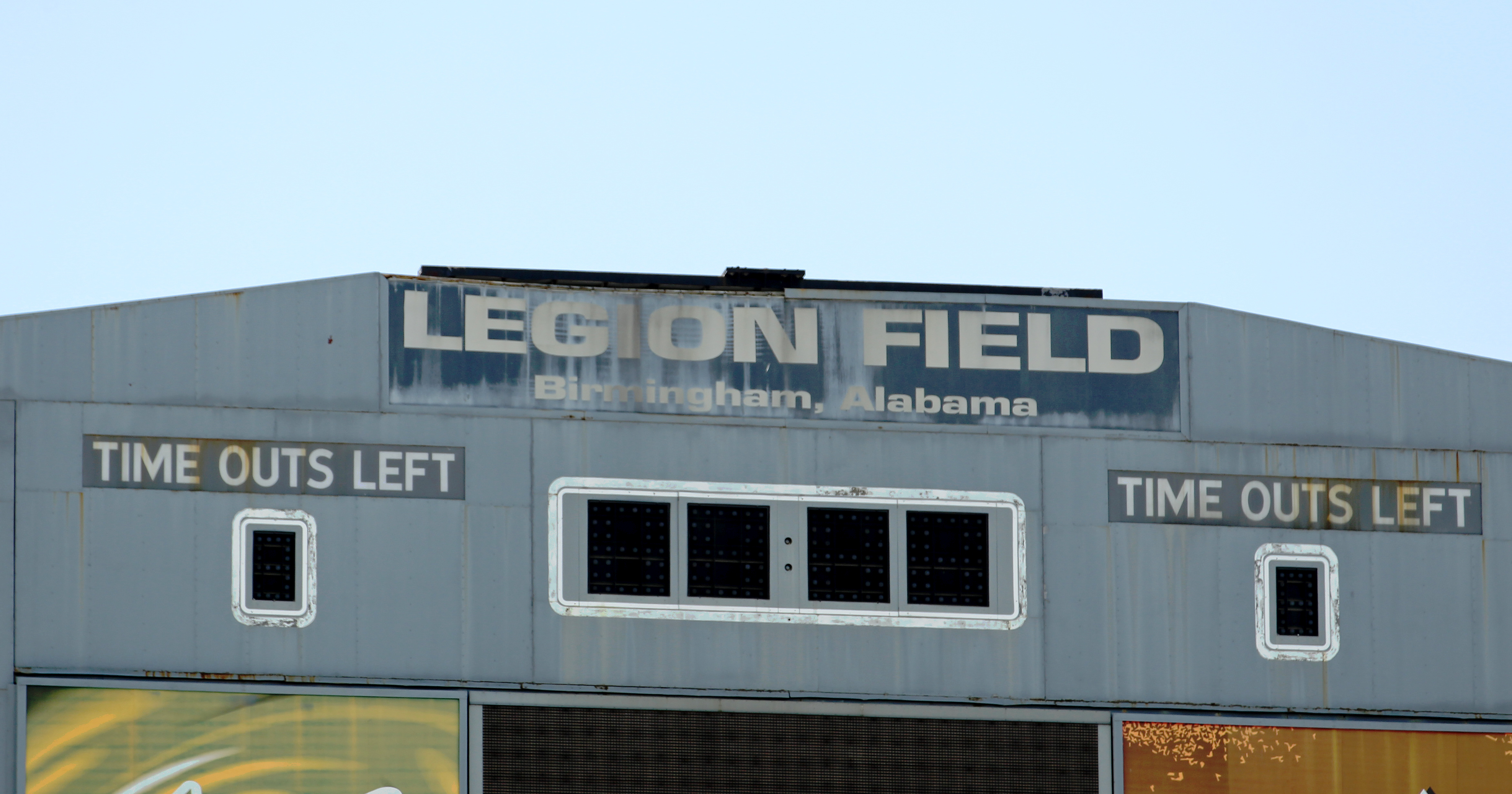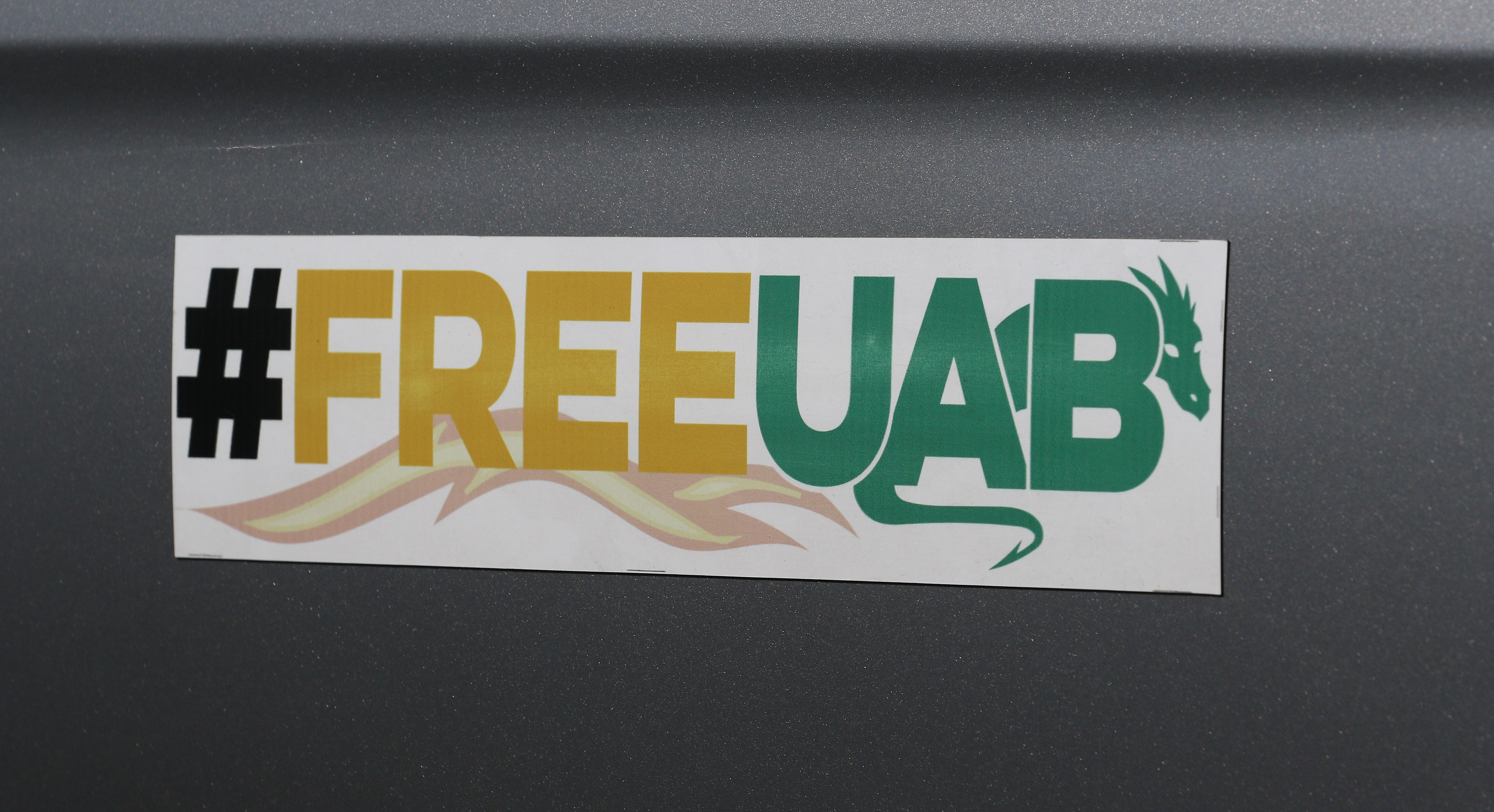UAB’s Bill Clark On Football Program Revival: ‘It’s Real Now’
UAB football returns in the 2017 season. After two seasons away from the FBS, head coach Bill Clark sees nothing but a bright future for the Blazers.
UAB football returns in the 2017 season. After two seasons away from the FBS, head coach Bill Clark sees nothing but a bright future for the Blazers.
There’s no need for Bill Clark to look back when the future appears to be so bright.
The UAB head coach, who is overseeing a football program that has been dormant for the last two seasons, has been preparing for roughly 20 months for the start of the 2017 college football season. So forgive him if he’s eager for the start of spring football, which the Blazers begin on Feb. 23 and complete with the team’s spring game on April 1.
However, the undertaking of such hard work and dedication to a program didn’t seem possible at one time.
December 2, 2014, is a somber date in UAB history. That was the day school president Ray Watts officially announced that he would be shutting down the football program, citing the rapidly increasing cost to field a competitive football team as the main reason. Per Watts, projected costs would have been $49 million over five years, with the figure only bound to escalate.
It was a blow to the entire university and community. And it essentially left Clark at a career crossroads after just one year with UAB following a successful run as a head coach at the high school level and a strong stint at Jacksonville State, which helped him land the job in Birmingham.
“It was tough, I don’t think there’s any doubt about it,” Clark told Campus Insiders this week. “Leaving Jacksonville State [for the Blazers’ head job] was a really hard move for me. It was my alma mater, and we really felt like it was headed in the right direction there. I was following Jack Crowe, who had done a good job there. So it was almost like we just needed to take the next step.
“I came to UAB, which was very downtrodden. But that’s one of those things that I like to be a part of: making a difference. And I’ve always felt that UAB could be very good. You have a great city, a great education and the love of football. That’s what really intrigued me when I took the job. Then for us to take a team that had really fallen on hard times for years, get them bowl-eligible and have it taken away from us…There’s no doubt it was tough.
“So I think it was a time of reflection and ‘What do I want to do next?’ But the Lord had a plan for us to get things back going. And now to be on the other side of things with these new facilities and everything that we always hoped to do here, with new stadium talk and everything … It’s an exciting time to be here after a really bad time obviously.”

UAB was the first major college football program to shut down since Pacific did so in 1995, and it came right after the program’s best record in a decade (6-6), becoming bowl eligible for the first time since 2004 and doubling its average attendance to more than 21,000 per game under their first-year head coach.
The ball started to get rolling for Clark and the entire program on June 1, 2015, when Watts announced the reversal of his decision to end UAB football. Watts’ change of course followed strong, vocal opposition to his initial ruling, as well as the fundraising of more than $27 million towards the program through the UAB Football Foundation, the city of Birmingham and the UAB Undergraduate Student Government Association. At the time, there was no exact date set for football’s return. But Watts told reporters that tangible commitments for additional support had been made that the program had never had before, making maintaining a balanced budget attainable.
On July 21, 2015, athletic director Mark Ingram said the NCAA informed the school that football can resume at the FBS level. Moreover, the team would be eligible for bowl games and Conference USA championships, should it meet qualifying standards.
Clark once again was presented with an opportunity to build up the Blazers.
Since the reboot, the 48-year-old has been tasked with strategically composing a roster that could compete with FBS foes, but he has had to do it since Summer 2015—knowing that it would be difficult to sell players on waiting so long to see the field again. Since the program became dormant, players such as wide receiver Jamari Staples (Louisville) and running back Jordan Howard (Indiana) went on to continue their careers elsewhere.
This past National Signing Day, Clark and his staff finished up a 20-player recruiting class that featured nine high school players, all of whom were in-state prospects.
“One of the things I thought we had to do a really good job of after the reboot was mapping things out,” Clark said. “One of the early things we decided was to go older. The makeup of our roster has been junior-college oriented. Now, what we’re trying to do is build things up with the high school players [those added earlier this month].
“What we did was come back on January 1 with the mindset of being like every other program in the country. We’re getting ready for spring ball next week, so that countdown clock will start toward the first game just like everybody else. It’s just been a different feeling, obviously, than from before because it’s real now. We can put ourselves in the same context as every other football-playing school in the country.”
That realness will be felt in UAB’s historic first game back on the gridiron on Sept. 2 against in-state foe Alabama A&M at Legion Field. Six games against teams that were bowl eligible last season make up the Blazers’ 2017 slate, as they will compete with Louisiana Tech, North Texas, Southern Miss, Rice, UTEP and UTSA for the C-USA West division crown.
So what exactly are the on-field expectations for the Blazers in 2017 considering that two full seasons have passed since the school has been able to field a football squad?
Clark mentioned that some of the only known commodities on the roster right now are the seniors, those few that stuck around when the program was dead and buried. Outside linebacker Shaq Jones, cornerback Darius Williams and offensive lineman Chris Schleuger are the backbone of the team, and Clark is interested to see who will step out of the shadows during spring ball.
One youngster to keep an eye on in 2017 is in-state linebacker Thomas Johnston, who is the brother of current Blazers quarterback Tyler Johnston. Thomas is the state of Alabama’s all-time leader in career tackles with 675, and was a four-star prospect in the 2017 class. It was a huge “get” for the once-dead program.
“I don’t know if you can really put into words just how big [that commitment] was,” Clark admitted. “When SEC schools are saying that ‘You’re our top recruit,’ that’s a pretty big deal. That’s what we were battling, so to get this guy committed to us really says where he sees the future of this program going. Because he could have gone anywhere—places that have 80,000 or 90,000 people coming to their games. So he sees where UAB can be and will be. So I think it was just huge.”

Clark and his staff have made a concerted effort to focus on the Birmingham area and the entire state of Alabama in recruiting as they try to build the program back up. Convincing area high school coaches and players that the commitment to football at UAB is different and much better now than in the past has been a top priority.
“There’s no doubt that we need to win locally,” Clark said. “These guys see it. The [high school coaches and players] have seen the lack of commitment in the past and now they are seeing the commitment. So they know we’re not an after-thought. It’s not like the old days.
“I think every kid we had in 2014 came in here and said, ‘Wow, I love Birmingham.’ And really, it’s a great size, it’s a Top 50 academic institution in the country and all those good things. Yet they were also wondering ‘Where is the commitment to football?’ And now we have it. So, functionality-wise, we’re going to have one of the best facilities in the country. Our building will have everything you can think of (it’s set to be ready in July). So when you start talking about recruiting, you see that [UAB] is back and it’s back the right way. And they’re making a commitment to football.”
The 2017 college football season is a big one for UAB, and it has nothing to do with wins and losses—though the more victories, the merrier. The fact that there will even be a season of Blazers football in the Fall is quite a feat in and of itself. Clark didn’t have to stay in Birmingham. But he persisted, eager to see his vision through. And the work has just begun.
“Our goal from Day One has been to be competitive,” Clark declared. “And that means we want to be playing and competing in every game. So if we do that, which I see us doing, we would have accomplished our goals above and beyond this first year.
“I’m kind of used to being in the hunt for all these games. So we’ve set a high standard. We want to compete and be competitive in every game. So that’s the goal this year.”
With an athletic department and the entire university lending the support the football program desperately needed, it’s no wonder why Clark has been so optimistic throughout the entire process of the UAB revival—one that seemed destined never to occur at all.
MORE: Group Of Five Playoff Idea Should Be Strongly Considered